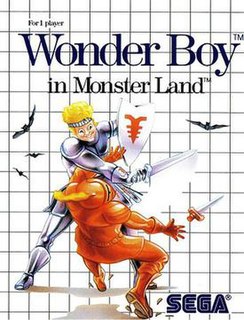
Wonder Boy in Monster Land, known by its original arcade release as Wonder Boy: Monster Land, is an platform video game developed by Westone Bit Entertainment and released by Sega in Japanese arcades in 1987 and for the Master System in 1988, with a number of other home computer and console ports following. The game is the sequel to the 1986 game Wonder Boy and takes place eleven years after the events in the previous game. After enjoying over a decade of peace on Wonder Land following the defeat of the evil King by Tom-Tom, later bestowed the title "Wonder Boy", a fire-breathing dragon called the MEKA dragon appeared; he and his minions conquered Wonder Land, turning it into "Monster Land". The people, helpless due to their lack of fighting skill, call for Wonder Boy, now a teenager, to destroy the monsters and defeat the MEKA dragon. Players control Wonder Boy through twelve linear levels as he makes his way through Monster Land to find and defeat the MEKA dragon. Players earn gold by defeating enemies and buy weapons, armor, footwear, magic, and other items to help along the way.
Telecomsoft was a British video game publisher and a division of British Telecom. The company was founded by Dr. Ederyn Williams in 1984 and operated three separate labels: Firebird, Rainbird, and Silverbird. The first employee was James Leavey, seconded from elsewhere in BT, who, along with Tony Rainbird, became the driving force behind the company in the early days.
Ocean Software Ltd was a British software development company that became one of the biggest European video game developers and publishers of the 1980s and 1990s.
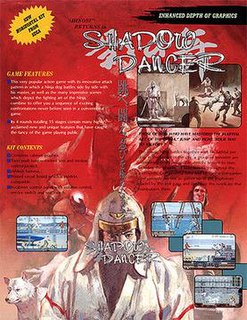
Shadow Dancer is a side-scrolling hack-and-slash action game produced by Sega and originally released as an arcade game in 1989. It is the second and the final arcade game in the Shinobi series, following the original Shinobi itself. The player controls a ninja aided by an attack dog, who is fighting to save the city from a terrorist organization.
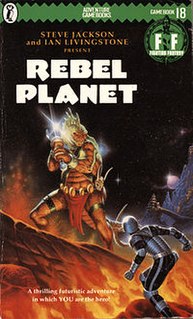
Rebel Planet is a single-player roleplaying gamebook written by Robin Waterfield, illustrated by Gary Mayes and originally published in 1985 by Puffin Books. It forms part of Steve Jackson and Ian Livingstone's Fighting Fantasy series. It is the 18th in the series in the original Puffin series (ISBN 0-14-031952-2). There are currently no announced plans to republish the book as part of the modern Wizard series.

Wonder Boy is a 1986 platform game published by Sega and developed by Escape. Originally designed for arcades, it was later ported to the SG-1000, Mark III/Master System and Game Gear video game consoles by Sega, and to the ZX Spectrum, Commodore 64 and Amstrad CPC home computers by Activision. The game is also known as Super Wonder Boy for its Sega Mark III release in Japan and Revenge of Drancon for its Game Gear release in North America. A high definition remake of the game, titled Wonder Boy Returns, was developed by CFK and released on Steam on October 12, 2016. Wonder Boy was rereleased in 2022 as part of Wonder Boy Collection for the Nintendo Switch and PlayStation 4 which includes its versions on arcade, Master System, SG-1000 and Game Gear.

Pac-Mania is an cavalier perspective maze game that was developed and released by Namco for arcades in 1987. In the game, the player controls Pac-Man as he must eat all of the dots while avoiding the colored ghosts that chase him in the maze. Eating large flashing "Power Pellets" will allow Pac-Man to eat the ghosts for bonus points, which lasts for a short period of time. A new feature to this game allows Pac-Man to jump over the ghosts to evade capture. It is the ninth title in the Pac-Man video game series and was the last one developed for arcades up until the release of Pac-Man Arrangement in 1996. Development was directed by Pac-Man creator Toru Iwatani. It was licensed to Atari Games for release in North America.

Outlaws is a video game for the Commodore 64 released by Ultimate Play the Game in 1985. In a break from earlier arcade adventure titles such as The Staff of Karnath and Entombed, Outlaws is a straightforward shooter game and does not feature the aristocrat adventurer Sir Arthur Pendragon.

Vigilante (ビジランテ) is a 1988 beat 'em up arcade video game developed and published by Irem in Japan and Europe, and published in North America by Data East. It is considered as a spiritual sequel to Irem's earlier Kung-Fu Master (1984).
Masters of the Universe is a media franchise based on a line of toys produced during the 1980s by Mattel.
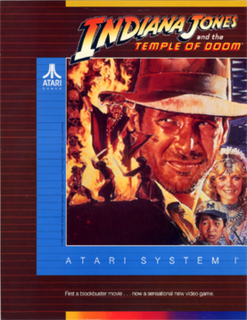
Indiana Jones and The Temple of Doom is an action video game developed and published by Atari Games and released in arcades in 1985. It is based on the 1984 film of the same name, the second film in the Indiana Jones franchise. It is the first Atari System 1 arcade game to include digitized speech, including voice clips of Harrison Ford as Indiana Jones and Amrish Puri as Mola Ram, as well as John Williams' music from the film.

Bionic Commando, released in Japan as Top Secret is a run-and-gun platform game released by Capcom in arcades in 1987. It was designed by Tokuro Fujiwara as a successor to his earlier "wire action" platformer Roc'n Rope (1983), building on its grappling hook mechanic; he was also the designer of Commando (1985). The music was composed by Harumi Fujita for the Yamaha YM2151 sound chip.
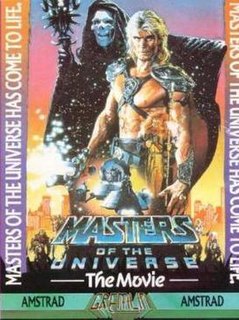
Masters of the Universe: The Movie is an action-adventure game developed by Gremlin Graphics, and published in 1987. It is based on the American film Masters of the Universe (1987), directed by Gary Goddard. The film and the game are part of the Masters of the Universe media franchise.

Masters of the Universe: Super Adventure, also known as Masters of the Universe in Terraquake, is an interactive fiction video game developed by Adventure Soft and published by U.S. Gold in 1986. The game is part of the Masters of the Universe media franchise. The game was adapted for the BBC Micro, Commodore 64, and ZX Spectrum home computers.

Tiger Road is a side-scrolling platform game originally released in 1987 as a coin-operated arcade game.

Line of Fire is a first-person light gun shooter game developed by Sega and released for arcades in 1989. It was released with two arcade cabinet versions, a standard upright and a sit-down cockpit, both featuring two positional guns. The cockpit design allows the player(s) to sit down while playing the game, while having two-handed machine guns, controlled by a potentiometer-controlled gun alignment software system. The game follows a two-man commando unit as they try to escape from a terrorist facility after seizing a prototype weapon.
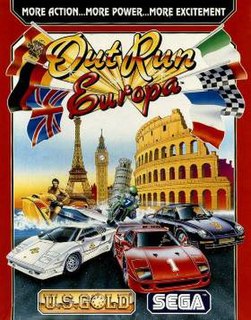
Out Run Europa is a racing video game developed by Probe Software and published by U.S. Gold for the Amiga, Amstrad CPC, Atari ST, Commodore 64, Game Gear, Master System, and ZX Spectrum in 1991. Only the Game Gear version was released in North America. It is a spin-off of Sega's 1986 arcade game Out Run.
Quattro is a series of video game compilations released in the 1990s. They consisted of games developed by Codemasters. The NES versions were released as multicarts and were published by Camerica without a license by Nintendo.














